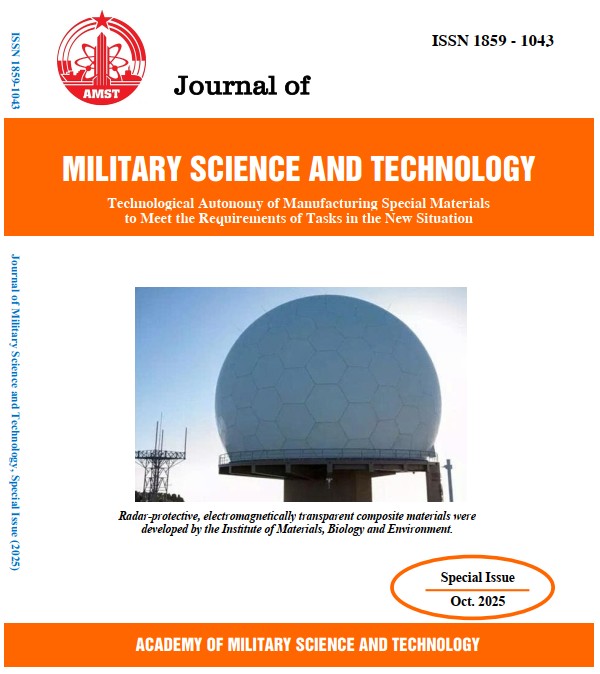Highly electrochemical stability of PEO-based polymer electrolytes for lithium-metal batteries
DOI:
https://doi.org/10.54939/1859-1043.j.mst.IMBE.2025.207-213Keywords:
Polymer electrolyte; Li-ion batteries; LiTFSI.Abstract
Polyethylene oxide (PEO)-based polymer electrolytes, incorporating lithium bis(trifluoromethanesulfonyl)imide (LiTFSI) and succinonitrile, are highly promising for solid-state lithium-ion batteries due to their superior ionic conductivity and electrochemical stability. Electrochemical impedance spectroscopy (EIS), electrochemical stability window (ESW) are used in this study to assess the electrochemical performance of the electrolyte system. EIS exhibits ionic conductivities exceeding 10⁻⁴ S/cm at room temperature because of the plasticizing effect of succinonitrile, which reduces PEO crystallinity, and the enhanced ionic dissociation of LiTFSI. ESW measurements demonstrate a stability window surpassing 4.8 V, enabling compatibility with high-voltage cathodes. GPE-Li3 (MW = 600,000; mSN:mPEO = 0.2; mLi:mPEO = 0.2) exhibits the highest ionic conductivity (2.79x10-4 S/cm) and applied voltage up to 4.2 V, can be considered a promising gel polymer electrolyte configuration for lithium metal batteries.
References
[1]. Y. Guo, H. Li, and T. J. A. M. Zhai, “Reviving lithium‐metal anodes for next‐generation high‐energy batteries”, Advanced Materials, Vol. 29, No. 29, p. 1700007, (2017).
[2]. I. Sumbulla, “Analysis of Prevailing Battery Innovations and Concept Technologies”, (2022).
[3]. K. Liu, Y. Liu, D. Lin, A. Pei, and Y. J. S. A. Cui, “Materials for lithium-ion battery safety”, Science Advances, Vol. 4, No. 6, p. eaas9820, (2018).
[4]. L.-Z. Fan et al., “Enhanced ionic conductivities in composite polymer electrolytes by using succinonitrile as a plasticizer”, Solid State Ionics, Vol. 179, pp. 1772–1775, (2008).
[5]. W. Lyu et al., “PEO-LiTFSI-SiO₂-SN system promotes the application of polymer electrolytes in all-solid-state lithium-ion batteries”, ChemistryOpen, Vol. 9, No. 6, pp. 713–718, (2020).
[6]. R. A. Huggins, “Simple method to determine electronic and ionic components of the conductivity in mixed conductors: a review”, Ionics, Vol. 8, pp. 300–313, (2002).
[7]. M. J. Lee et al., “Elastomeric electrolytes for high-energy solid-state lithium batteries”, Nature, Vol. 601, No. 7892, pp. 217–222, (2022).
[8]. J. Zhu et al., “In situ 3D crosslinked gel polymer electrolyte for ultra-long cycling, high-voltage, and high-safety lithium metal batteries”, Energy Storage Materials, Vol. 57, pp. 92–101, (2023).
[9]. K. Platen, F. Langer, R. Bayer, R. Hollmann, J. Schwenzel, and M. Busse, “Influence of molecular weight and lithium bis(trifluoromethanesulfonyl)imide on the thermal processability of poly(ethylene oxide) for solid-state electrolytes”, Polymers, Vol. 15, No. 16, p. 3375, (2023).
[10]. F. Croce, G. B. Appetecchi, L. Persi, and B. Scrosati, “Nanocomposite polymer electrolytes for lithium batteries”, Nature, Vol. 394, No. 6692, pp. 456–458, (1998).
[11]. J. Mindemark, M. Lacey, T. Bowden, and D. Brandell, “Beyond PEO—Alternative host materials for Li⁺-conducting solid polymer electrolytes”, Progress in Polymer Science, Vol. 81, pp. 114–143, (2018).
[12]. M. Armand, F. Endres, D. R. MacFarlane, H. Ohno, and B. Scrosati, “Ionic-liquid materials for the electrochemical challenges of the future”, Nature Materials, Vol. 8, No. 8, pp. 621–629, (2009).
[13]. C. Wang et al., “Differentiated lithium salt design for multilayered PEO electrolyte enables a high-voltage solid-state lithium metal battery”, Advanced Science, Vol. 6, No. 22, p. 1901036, (2019).
[14]. A. Maurel et al., “Poly(ethylene oxide)–LiTFSI solid polymer electrolyte filaments for fused deposition modeling three-dimensional printing”, Journal of The Electrochemical Society, Vol. 167, No. 7, p. 070536, (2020).







